The material included below provides insights into my teaching philosophy and the way that it manifests itself in my courses with specific examples. This section also includes sample course projects and exercises (which demonstrate student success), letters of support from faculty and community partners, sample syllabi, evidence of advising, and student references.
Teaching Philosophy
The ultimate goal of the educational experience is to help students acquire skills (tools), experiences, and perspectives that will help them lead...
Read MoreMeaningful education takes dedication and hard work on the part of the student and the teacher. We need to create an environment, that challenges students to do more than they know they can do, in a way that is both fun and interesting. The teacher must be willing to learn from students as well. We all have so much more to gain by establishing a collaborative partnership with educational excellence as the objective.
Teaching Philosophy In Practice
So, with these thoughts in mind… Here is how they translate into practice.
In the classroom, the focus is on having a guided discussion with students rather than just lectures. I ask questions to get students engaged in the discussion. A portion of the grade for my on campus courses includes attendance and participation. When students are not participating actively, I call on them to get them more involved in the discussion and help build their participation points. I like to know (and call on) my students by first name in order to make the conversation more personal. This type of interactive learning can help keep the class material interesting and keep students connected to the topic(s).
The class sessions are guided with PowerPoint slides. This helps with the structure and flow of class. The slides are posted on Canvas in advance of class. A liberal amount of video clips and exercises are used throughout the discussion. The whiteboard is used to highlight important points and walk through specific examples. The variation in learning medium helps break up the flow to keep things fresh and interesting. Students these days are used to consuming video on their smartphones and computers. By embracing this medium, and other digital tools, we can create more engagement then a canned lecture would provide.
When selecting discussion topics and videos, I try choose topics that are related to popular culture or current events. Class discussions become a lot more meaningful for students when they can see these same concepts at work in everyday life. There are discussion segments that investigate “the numbers” behind the Super Bowl, Halloween, Thanksgiving, Christmas, and even Cinco de Mayo – in our economy there is a business component to most holidays.
It is one thing to talk about buyouts, takeovers, and the dangers of having too much leverage (debt) in a firm’s capital structure. It is quite another to play news reports covering the Haggen acquisition of 146 Safeway/Albertson stores in 2015 (growing from 18 to 164 stores overnight); and then tracking their progress in factoids and news clips; including the high profile bankruptcy that occurred less than 12 months later. In classes where we have this discussion, most of the students can point to a store in their home town, or someone they know, who was affected. This not only gives us the opportunity to discuss the course concepts (e.g. finance, marketing, strategy…), but also how this type of behavior impacts students and the entire community (social responsibility).
In marketing class, rather than just talking about differentiation and positioning for consumer products, I show students different brands of macaroni and cheese – most students can identify with this example. We talk about their own preferences and buying behavior. Some students have a brand preference for national brands like Kraft, and are willing to pay the premium for it; while others would prefer the house brand to save a couple bucks. We explore pictures of the packaging and see that not all house brands are the same either. We can talk about different product variations (e.g. boxed, packaged with liquid cheese, canned, frozen, warm from the deli counter, …) and what providers are trying to accomplish with each offering.
In many cases, I take this one step further and get the students to step outside the class and engage with their environment as well. So, in this example, I send students to the store and tell them to take pictures of the offerings, along with displays (if any), and come back to class prepared to discuss what they saw. This tends to make the concepts even more concrete and gets students actively involved in the topic.
In marketing class, to re-enforce a discussion on creativity and innovation, we created our own episode of Chopped, modeled after the Food Network TV show, with macaroni and cheese as the featured ingredient. Students worked together to create the rule for the contest, I provided the noodles and a host of different ingredients, and the students had to create offerings to reach different (consumer) audiences. The woman’s softball team came in to judge the event for us. The students who were in this class still bring it up when I see them. In fact, some students who were not in the class, ask me when we will offer this again.

Now to specific classes
In marketing promotions, I worked with students to make a list on the board of all the possible places they could go to buy a pizza. We worked together to prioritize this list. Then the students broke into groups and each group went to visit one provider on the list. They took pictures, interviewed at least one person working there, and got information on pricing and delivery (where available). Then they came back to class and we mapped each offering based on target audience, price point, key attributes of the offering (pizza, location, setting …), and other relevant factors. As the exercise developed it became much easier for students to identify specific market segments and the marketing mix associated with each offering.
These students were able to discover the lesson, based on their own experience, and working with a topic that was meaningful to them. We finished off the session with a pizza from Domino’s. We also hosted a session with Jessy Watson, owner of the local Domino’s franchise, and Assistant Coach of the men’s soccer team, so that he could share the challenges and rewards of competing as a pizza provider in the local market.
We’ve had students conduct surveys on campus and in the community, visit local stores and businesses, and experience offerings we are studying first-hand. We can’t do this kind of thing for every lesson, but when we can, the students appear to be much more engaged, and recall seems to improve. I do my best to connect the classroom to the outside world, and the community, whenever possible.
In addition, in all my classes we embrace technology like email, Canvas, Zoom, and YouTube. Courses, both online and on campus, are organized in Canvas by weekly module. The readings, discussion topics, and assignments for the entire term are laid out. All assignments must be submitted on Canvas (no paper). Quizzes are also administered on Canvas which saves valuable class time and also provides students with immediate feedback. This also allows students to track their grades and even perform “what if” analysis on future assignments (grades). Our graduates will work in a world where technology and automation are commonplace and both will continue to advance quickly. Our students need to be comfortable working in this environment with contemporary tools.
Finally, one of the most powerful techniques is to expose students to hero’s – those who have been successful in a professional environment – business people, entrepreneurs, elected officials, thought leaders… Our students need to be exposed to successful people, learn from their experiences, and take away the idea that “if they can do it, I can too!” We invite these inspirational leaders to class either in person or virtually using tools like Zoom. Pub Talks (see eClub) were established on the same basic principle. Here is representative sample of class visitors (30+) we have hosted.
Now to specific classes…
BA 498, Business Policy & Strategy, is the capstone for undergraduate business students, and is a course that I’ve taught for many years, at several different universities.
The goal of the capstone is to bring together everything that students have learned from their degree program – accounting, finance, marketing, management, operations, and more. We do this on two different levels. First, students are required to cover the core business policy and strategy curriculum presented in the textbook – augmented with current examples/readings. This includes readings, class discussions, and online exams to help evaluate progress.
Students are also required to complete a real-world group consulting project with a community partner. The projects chosen benefit the community in some way, but they also give the students the opportunity to apply their skills in a practical fashion. The projects also have enough substance that they can be used on the students resume and they also have the opportunity to build professional contacts that could help in the future.
Unlike problems pulled directly from the textbook, these problems do not have just one right answer. I build relationships with the client and manage the projects for the class. However, students have to negotiate a Statement of Work (SoW) and a set of deadlines directly with the client. They need to manage common problems like incomplete data, unrealistic client expectations, phone calls that are not returned, team partners who do not contribute fully or communicate well … This is just like the real world.
This is a new experience for most students. There are many who just want “the answer” – even though there may not be one “right” answer. Honestly, in life, there are times when there are no good answers. Sometimes we just have to choose the least objectionable of the bad outcomes that are available.
I work hard to coach and nurture them through the process. We discuss obstacles and different approaches and tie them to concepts that are discussed in the curriculum. Students can sometimes have a “deer in the headlights” look for the first six weeks and then break-through and deliver. There is tremendous pride visible pride once students have presented the final results to the client.
The projects are presented to the client in person for on-campus courses – online students develop a YouTube presentation to share with the client. Students are required to present their work professionally, answer questions in real-time, and explain/defend their results and recommendations.
In general, clients are pleasantly surprised with the results and grateful for the help. This sentiment is communicated by clients in the reference letters to the right. In fact, at a recent Pub Talk event (1/9/2019), Nicole Lewis, a rising country music star, praised the work of our BA 498 students, and shared their work with the audience. The bulk of our current work comes from the referrals of prior clients.
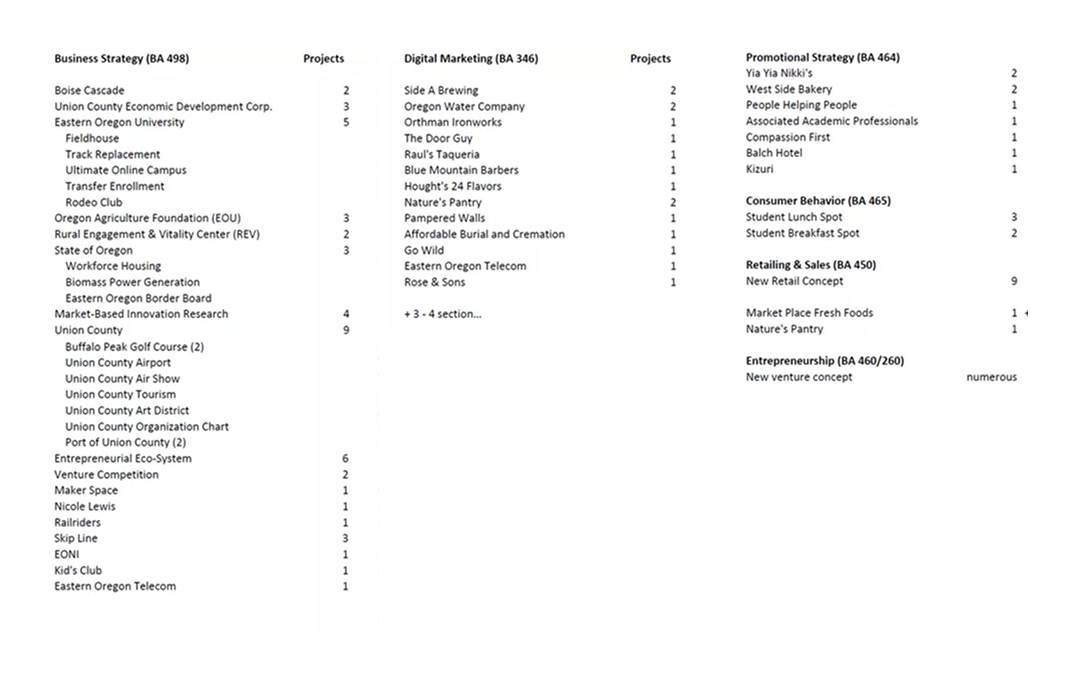
test453
2021 Economic Outlook, Kruse Way Economic Forum, April 21, 2021
Beyond the capstone
BA 464, Promotion Strategy, and BA 465, Consumer Behavior, are two areas of marketing where we spend time learning more about target markets, buying behavior, building awareness, and driving sales. The last time this course was offered we built promotional plans for two local businesses – West Side Bakery and Yia Yia Nikke’s. Students visited both businesses, talked with the owners, learned more about how they operate, and made an effort to understand their vision. Students then owned the task of defining the missing elements of the marketing mix (5 P’s) and producing a promotional plan the owners could execute with a total budget of less than $5,000.
We finished up the term with a coffee hour and a student presentation. The business owners spent one hour sharing samples of their food with all College of Business students and answering questions. Then students presented their promotional plans (in class) and answered questions. The ultimate goals of this exercise was for students to learn while doing, to forge a tighter relationship between EOU and the community, and to help two small cash-starved businesses be successful. Both the students and the business owners reported that this exercise was a success.
In prior terms students have had a chance to design a food truck offering, create the ultimate breakfast spot, and design the best possible lunch destination. These projects included visiting existing providers, conducting university-wide student surveys, and exploring what other campuses have to offer. These are all practical skills, used in industry, that students have a chance to master.
BA 346, E-marketing, teaches students how to market products and services online. This class has evolved from a (mostly) empty shell with the textbook slides posted, to a much richer hands on experience. Students now acquire deeper technical knowledge with practical projects and exercises. Students learn to write simple HTML, build a personal website, create a LinkedIn profile, and use social media to promote a business. They also learn the essentials of getting a business online, getting noticed (e.g. SEO, PPC, banners, blogs…), and creating a buzz (e.g. email, viral marketing, social media…).
The term project is to develop an online marketing plan for a local business with no more than $1 million in revenues. The students approach a business and ask for permission to perform an analysis and online marketing plan. They interview the owner to understand the goal(s) for their business, which tools are being used, and the budget available for future promotions. Then the students perform a situation analysis and apply what they have learned in class to build an online marketing plan. The plan that they have developed is shared with the owner of the business. Blake Bars, General Manager of Nature’s Pantry, a recent client expresses his thanks in the letter to the right. This is pretty typical of the responses we receive from our business clients.
Examples of specific BA 346 projects are called out in the project list presented earlier. There are several examples of student work product below. We completed five more of these projects for local businesses in Fall 2019 alone.
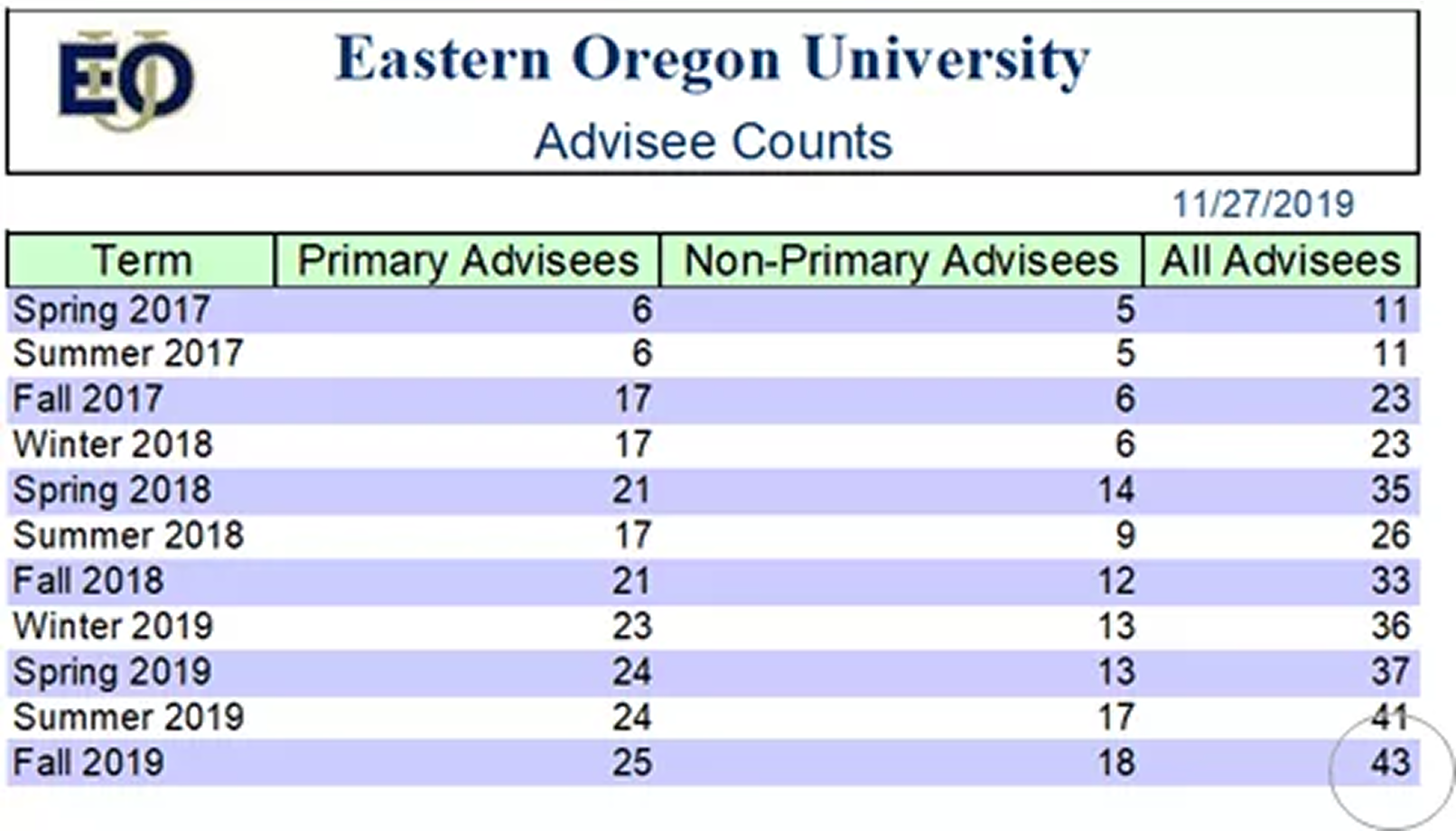
Institutional Records and Descriptive Information
A complete list of all the courses that I’ve taught since coming to EOU included below. The grade distribution for these classes is also included.
As discussed earlier, BA 498 classes require students to complete a consulting engagement with a community partner. This is summarized above and examples are provided. In addition, most of my upper level courses require the students to complete a group project. Whenever possible, we engage with a community partner, and solve real world problems.
In 2015 I performed an analysis of the marketing curriculum offered by other regional universities in our area, we discussed this material as a marketing faculty, and then made the recommendation to retain our marketing concentration. You will find a diagram below that outlines our offerings in marketing and shows how they relate to each other and to the topic. In addition to teaching the marketing core (BA 312), and most of the our marketing electives, I also teach Entrepreneurship (BA 260, BA 460), Finance (BA 313), and Business Policy and Strategy (BA 498 – the capstone).
I developed two courses from scratch of the last two years, BA 260, Introduction to entrepreneurship, and BA 454, Product Planning and Development. I also worked with OSU to assure that BA 260/BA 460 qualify as transfer credits. I’ve completed 19 new course preps since starting at EOU.
I continue to work on initiatives across campus relating to entrepreneurship. There is more information on this activity in Contribution to Institution.
I was a member of the team that spent a year redesigning our MBA curriculum. In fact, many of the course syllabi for our core courses, and some potential electives were written by me. You will find links to sample course syllabi below. I also developed the MBA personas to help capture the type of student we are targeted and wrote an initial marketing brief for University Advancement to market the program.
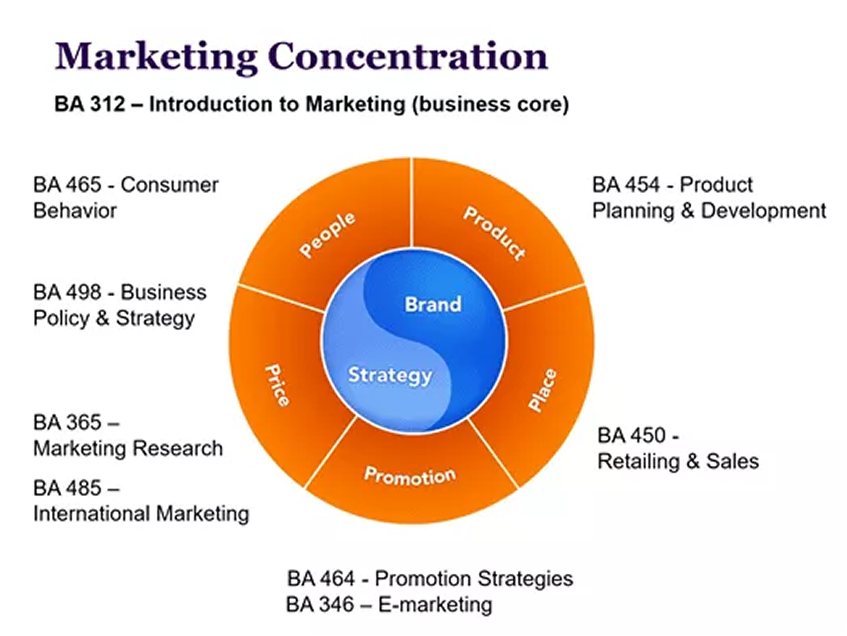
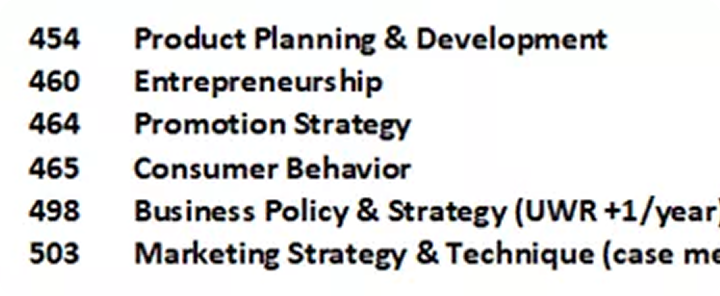
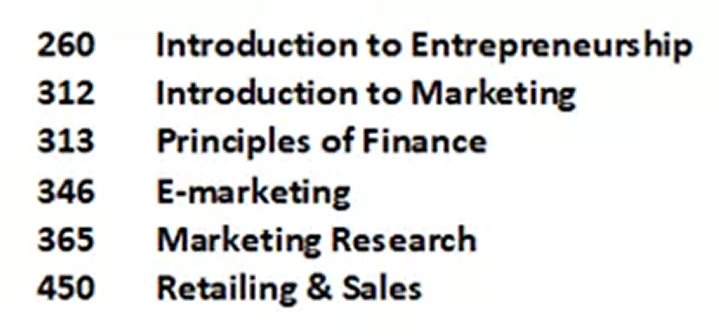
test453
2021 Economic Outlook, Kruse Way Economic Forum, April 21, 2021
| Course Load | Credits | New Preps |
|---|---|---|
| 2015 - 2016 detailed view | 60 | 8 |
| 2015 - 2016 detailed view | 60 | 8 |
| 2015 - 2016 detailed view | 60 | 8 |
| 2015 - 2016 detailed view | 60 | 8 |
Classroom Observations
Dean Mielke (retired), College of Business and Education visited two of my classes (one on campus and one online) in 2017. Dean Henninger, College of Business, visited two of my classes this term and reviewed my online course materials. Peter Maille and Bill Grigsby, both tenure faculty, performed classroom observations and reviewed my online course shells. Classroom observations were previously performed by tenure faculty members Gary Keller and Shari Carpenter. Links to the formal class evaluations can be found on the right.
Scott McConnell, Steve Clements (retired), Doug Briney, and Peter Maille (tenure faculty) have all attended my classes for student presentations and/or exercises. Luke Aldrich also attended a recent class and provided an informal review (right).
As discussed earlier, we have frequent class visitors (speakers), and we present projects to community partners. We have had the opportunity to welcome many people into our class to participate. A representative (not exhaustive) list would include: Tom Insko (EOU President), Tim Seydel (VP, University Advancement), Ben Welch (EOU Track Coach), Steve Clements (Mayor of La Grande), Jack Howard (Union County Commissioner), Scott Fairley (OR Governor’s Office), Randy Jones (OR DEQ), Troy Little (Division Manager, Boise Cascade), Steve Lyon (Human Resources Manager, Grande Ronde Hospital), and many more.
Alumni
The names of twelve reference students are included below. This sample stretches across my time at EOU, with nine undergraduate alumni, and three current/past MBA students. In addition there are reference letters from former students at Concordia University and Portland State University. There are also several letters from past/present students on the right.

